- Author Arianna Cook [email protected].
- Public 2024-01-12 17:55.
- Last modified 2025-06-01 07:38.
Distinctive features, rules for growing lobivia, recommendations for independent reproduction of a cactus, diseases and pests, interesting facts, species. Lobivia (Lobivia) refers to the genus of plants included by scientists in another genus, called Echinopsis (Echinopsis). Both of these genera are part of the large and oldest family Cactaceae. There are also 70 to 100 species of such representatives of the flora. The native area of natural distribution of these plants falls on rather limited territories, which are stretched from the highlands of Peru, as well as in Argentina and Bolivia. It was at the last place of its "residence" that Lobivia received its name, which is an anagram (a technique due to which letters or sounds are rearranged in a word).
The appearance of lobivia directly indicates its relationship to the cactus family. The plant, when still young, has a symmetrical stem with spherical outlines, which subsequently takes the form of a cylinder. It is to its stem that the plant owes its self-preservation property during dry periods, since a certain amount of liquid accumulates in it, which helps the cactus to survive. The size of the stem in height ranges from 2 to 50 cm with a diameter of 3-15 cm. The stem is colored in shades ranging from light to dark green. Its surface is covered with straight or rather original curved spines. The root of lobivia grows in the form of a rod or has a turnip shape, its type directly depends on the nutrient layer of the substrate in which the cactus grows.
There is practically no branching at the stem, however, this cactus has a large number of basal processes - children. It is because of such daughter formations that Lobivia, in the conditions of natural growth, is trying to conquer nearby territories, the thickets of its children are whole colonies, which in their outlines resemble furry pillows. The ribs on the stem can be either sharp or of varying degrees of roundness. On the ribs there are tubercles, carrying areoles, in which bunches of hard spines grow.
When flowering, buds appear, located singly or in groups, around the stem, in areoles located on the lateral surface of the stem at the apex. Flowers have a separate-petalled shape, the corolla is funnel-shaped. Pedicels with dense pubescence, but occasionally they can be covered with thorns. The length of such a pedicel is sometimes measured 20-30 cm. The dimensions of the corolla tube in length can reach 30 cm, and the diameter in the opening is equal to 15 cm. The color of the corolla petals is quite diverse (from snow-white to bright crimson or pinkish-purple), and there are varieties, in which it is even multicolored (mottled). From the flowers, the stamens hang down picturesquely, placed in the middle, attached to elongated shiny threads. When the lobivia is already adult, up to 25 buds can open on it at the same time. However, the flowering period of each bud is only 1-3 days. The flowering process takes place from May days to the end of summer.
This is followed by ripening of fruitlets, which have the shape of a box, with a length of up to 1-1, 5 cm, painted in green or red color.
Today, in addition to the basic varieties, there are hybrid representatives, which are distinguished by the variegated coloring of both flower petals and stems. The surface of the stems is decorated with intricate weaving of thorns.
Home Lobivia Care Tips
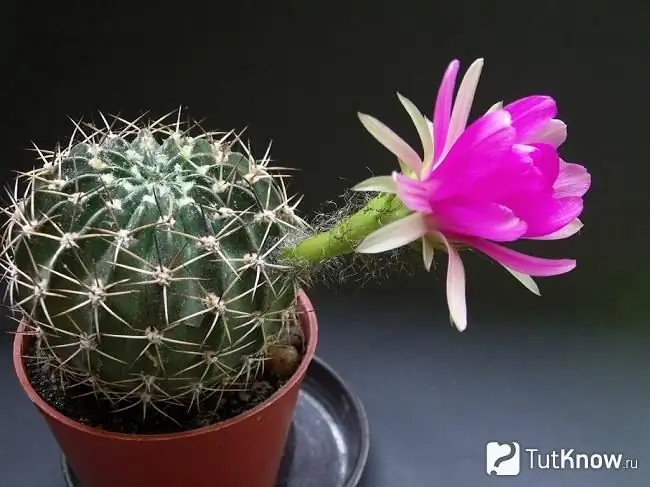
- Lighting. This cactus is photophilous and the best place for it is on a south-facing window, otherwise it should be illuminated with fmitolamps.
- Content temperature. When caring for lobivia, it is important to maintain room temperature, within 20-24 degrees. But this cactus needs changes in day and night heat indicators. Therefore, you can take the pot with the plant to the open air and keep it there from mid-spring to October. They select a place with shelter from precipitation. In winter, the cactus has a dormant mode, and at this time the temperature should be 8-10 degrees. This will be the key to the subsequent abundant flowering.
- Air humidity when growing lobivia does not play a significant role.
- Watering. To please yourself with the flowering of a cactus, it is recommended to simulate periods of drought. The first is from mid-June to mid-August. After this time, the soil is abundantly moistened and lobivia is watered carefully until the end of autumn, avoiding gulfs - once a week, otherwise the stem will begin to rot. The second period of drought is the entire winter. When the first flower buds appear, the cactus will be watered again once a week. During the budding period, it is important that the soil in the pot does not dry out completely, otherwise the plant will drop buds and flowers. The water is soft and warm.
- Fertilizing lobivia. For a cactus to grow comfortably, you need to feed it with extreme care. Frequency at least twice a month in spring and summer. If the preparations contain a large amount of nitrogen, then the plant will increase its vegetative mass due to the formation of flowers. In the period from October to March, when the cactus is dormant, you do not need to fertilize it.
- Transplantation and selection of a substrate. If your lobivia has become cramped in an old pot, and the root system has mastered the entire earthen lump, then a transplant should be carried out in the spring. The new capacity is selected low and wide, since the roots of this cactus are located superficially (almost horizontally) and at the same time they give a lot of lateral daughter processes. When transplanting, a highly expanded colony is usually thinned out. At the same time, the soil should have neutral acidity, be loose and with good air and water conductivity to the roots. It is recommended to use substrates for cacti, but only add a little fine gravel (up to 10% of the total volume) and coarse sand to them. You can make up such a soil yourself from turf soil, humus and river sand. Before planting lobivia, the substrate is disinfected. To do this, the mixture is poured with boiling water, with manganese diluted in it, and then the soil mixture is calcined in the oven for 3 hours.
How to multiply lobivia on your own?
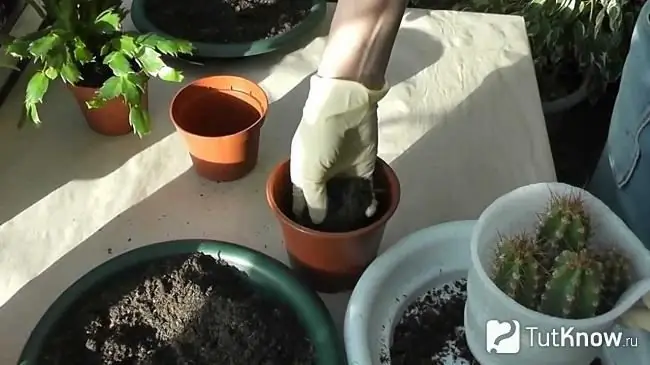
To get a new cactus with beautiful flowers, sowing seed material or planting root shoots should be carried out (there are a lot of them in lobivia over time).
If the choice fell in the direction of vegetative reproduction, it is recommended to carry it out carefully, separating the lateral shoots - children from the mother cactus. Then the parts are left for 20-24 hours so that the slices dry out and the liquid stops oozing from them. After this time has elapsed, the children are planted in a soil mixture, in which the lion's share of coarse-grain sand is present. When the parts of the lobivia take root, it is recommended to transplant them into a permanent pot with a selected substrate for further growth.
You can purchase seeds of this cactus at a flower shop and follow the recommendations on the package. If possible, the seeds are used from the grown fruits of a home plant, which are formed in the form of bolls after the flowering process. Seed material must be kept for 24 hours in warm water or in moist tissue - this will help them germinate faster. Then the seeds are planted in pre-prepared bowls or small pots. The substrate is peat-sandy, in which there is slightly more sand than peat. Sowing is carried out in the winter months of the year, so that by the spring days the seeds will germinate, and you can begin to distill them under the first warm sunlight.
Reproduction is rarely used by inoculation in the butt. In this case, the stem of a young, non-lignified rootstock is cut (so as not to "chew") the stem with the help of a sharp and disinfected knife so that only the lower part with the required length remains. A thin strip is cut from the cut part and applied to the stock so that the cut does not dry out. Then the top of the scion is cut off and both parts are connected, having previously removed the protective strip (scion with stock). Before that, it is necessary to round off the sharp edges of the parts so that the fit is complete and then the parts do not bend. It is better to secure the stock with a peg for stability. It is important to connect the parts (scion and rootstock) so that the centers coincide exactly along the conducting beams, at least in one place. The graft is screwed into the stock in a circular motion, as it were - there should be no bubbles between them. Then, using rubber rings, parts of the scion and rootstock with a flowerpot are fastened crosswise.
Since the stock is wider than the scion, its open places after the alignment procedure are powdered with sulfur or coal powder. Then the whole structure is placed in a greenhouse. And watering is not carried out until the cut is dry. Then you can raise the temperature to 25 degrees and humidify. At the same time, make sure that drops of liquid do not fall on the vaccine. It is recommended to remove the bandage after 1-2 weeks.
If you can see that the cut site has dried up, and the scion has roots and has faded a little, then this is a sign of an unsuccessful vaccination. It is also possible to inoculate in a cleft or wedge.
Difficulties in growing lobivia cactus and ways to overcome them
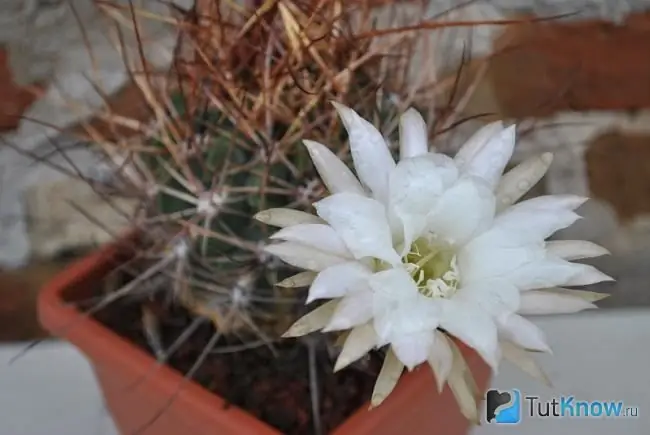
The pests that can infect this cactus are recognized: aphids, scale insects, false scale insects, spider mites or mealybugs. If there are obvious traces of harmful insects (thin cobweb, brown plaques, small green or black bugs, or formations in the form of whitish pieces of cotton wool), then it is necessary to carry out treatment with insecticidal preparations.
When the soil in a pot of lobivia is often waterlogged, the plant can be affected by root rot. If the disease has covered a small area, it is recommended to remove the cactus from the pot, remove the affected areas, and treat the rest with fungicidal preparations. Then it is transplanted into a new container and a disinfected substrate.
Interesting facts about lobivia
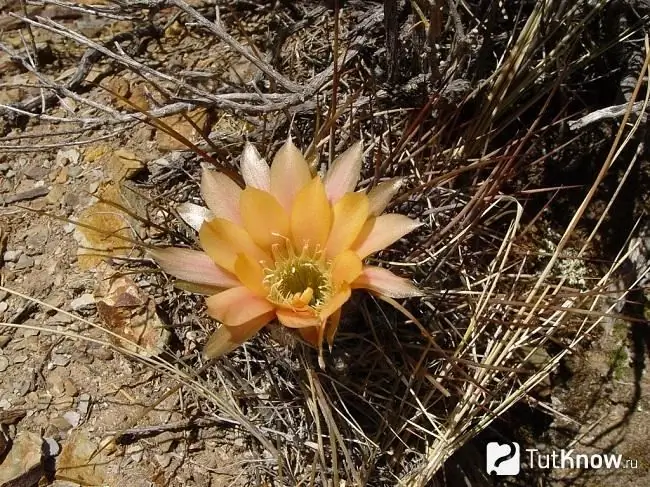
It is curious that in everyday life, flower growers call lobivia differently. Many believe that it is correct to call it "Echinopsis" (in Greek it means "like a hedgehog"), based on the genus to which this plant is assigned today. It was first described by Karl Linnaeus, who was engaged in the taxonomy of the entire plant world, known at that time. The scientist singled out lobivia as a separate subspecies due to the small and covered with thorns stems that have rounded, cylindrical or columnar shapes. Later, some botanical scientists came up with the idea of separating Lobivia into a separate genus.
Also, if you look at this cactus and, despite its great similarity with echinopsis, there are certain distinctive features:
- since lobivia is evolutionarily younger than its "brother", this is expressed in high properties in adaptation to the environment, and also varietal and species hybrids are obtained quite easily;
- this plant, in its external structure and habit, is slightly smaller than Echinopsis, but all varieties of lobivia have more voluminous areoles and the needles also take on larger sizes;
- there are differences in the size of flowers, as well as their color range, the number of petals in the corolla, there is a wide variety in shades that take on cactus stems - from grayish-green and rich green to brownish.
Until now, there is no clear distinction between the above genera, therefore it is not uncommon that the main representative of the genus bears the name of both Lobivia and Echinopsis. If we take, for example, a variety of Sylvester's Lobivia, then you can hear how it is called Chamecereus Sylvester, and sometimes even called Echinopsis hamecereus.
Lobivia cactus species
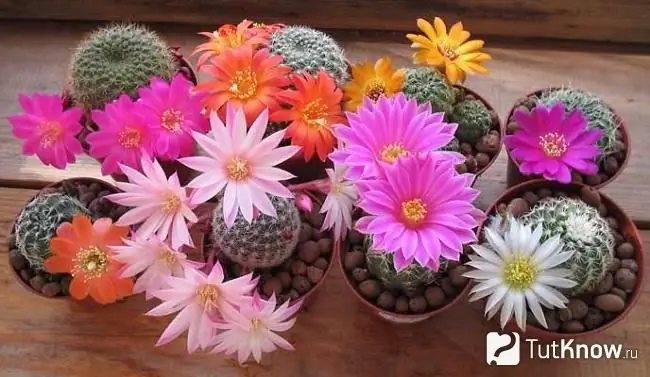
- Lobivia arachacantha is a cactus of compact dwarf size, the height of which reaches only 4 cm. The stem has smooth and not sharp edges, including 14 units. Their surface is densely covered with spines tightly pressed to the stem, which originate from small tubercles. During flowering, buds are formed, which, opening up, have a diameter 2-3 times larger than the diameter of the stem itself. The color of the petals in the corolla is rich yellow. There are varieties in which the flowers are cast in a red color, with elongated stamens, which are crowned with snow-white anthers.
- Lobivia gold (Lobivia aurea). The height of such a plant in an adult form can fluctuate between 20-50 cm, while the stem diameter is 12 cm. The ribs are pronounced and differ in rather sharp edges. From each areola, two pairs of central, strongly thickened spines originate, which can reach a length of 2-6 mm. There are also 8-10 radial spines with a length of 1-2 cm. These spines form a bizarre pattern that resembles a cobweb. The flowers are large in size, opening up to 10-15 cm in diameter. Their petals are colored in a yellowish-lemon color, while inside the calyx there is a spot of a rich yellow hue. Thanks to breeding work, varieties with flowers that have pinkish, snow-white, lilac and red petals are already known.
- Lobivia Tigeliana (Lobivia tiegeliana). This cactus has a height of 10 cm and a stem diameter from 4 to 6 cm. The ribs, which adorn the trunk, are wide and at the same time low. Each of the areoles bears spines with their outlines resembling needles, their number varies within 10-20 units. At the same time, those that grow in the center of only 1-3 pieces, their length reaches 10 mm, and all others are thinner - radial grow to a length of 6-10 mm. During flowering, flowers are formed of rather small sizes, with a length of only 2.5 cm, and when fully opened, their diameter is 4 cm. Their petals are painted in a reddish-lilac color scheme.
- Lobivia famatimensis (Lobivia famatimensis). This variety of cactus is distinguished by a large number of ribs, the outlines of which are quite clearly distinguishable. Ribs are sharp. Their number on the stem can reach 24 units. The spines are thin and very short, so it is quite problematic to distinguish them, since they are tightly pressed against the surface of the stem. In the process of flowering, buds are formed with petals of a rich yellow or bright yellow hue. The length of the flower is measured in three centimeters, and the diameter, when the bud opens, can reach six centimeters.
- Lobivia jajoiana. The size of this cactus variety is also quite compact. The stem has a spherical shape, its diameter can vary from 8 to 10 cm. It has a lot of compressed ribs, which are covered with strongly pronounced tubercles of the areola. Thin spines of dark color originate in them, which number up to 15 units. The longest spines are located in the center, their length is equal to 7 mm. The variety is quite popular due to its large flowers, which have a goblet shape. Their petals can acquire deep red, fiery red or yellow shades, but the throat of the corolla is quite wide with a purple tint. Stamens with anthers, which give the flower a spectacular appearance of snow-white color, peep out of the flower, which stand out perfectly against the background of the petals.
How to properly transplant lobivia, see the video below:






